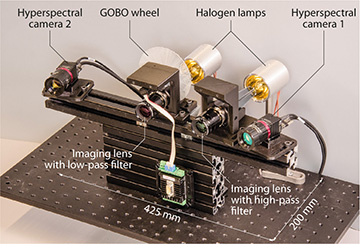
The new hyperspectral imager contains two cameras and measures just 425 mm by 200 mm. With further miniaturization, it could be incorporated into smartphones for personal use. [Image: Stefan Heist, Friedrich Schiller University / Fraunhofer IOF]
As hyperspectral imaging finds more applications in diverse fields ranging from medicine to geology, scientists are looking to shrink imaging system size as well as improve performance. Researchers in Germany have built a compact hyperspectral-imaging system that collects five-dimensional data yet takes up roughly the area of a laptop computer (Opt. Express, doi:10.1364/OE.26.023366).
2 cameras + GOBO = 5-D
The new system scans objects in the x, y and z spatial dimensions and at multiple wavelengths of light, and records the data as a function of time—hence the “5-D” specification. Many existing hyperspectral-imaging setups record data in two spatial coordinates. The proof-of-concept device does not need to touch the object it is scanning, so it would avoid damaging fragile targets, such as ancient works of art.
In building the hyperspectral system, group leader Stefan Heist of Friedrich Schiller University and the Fraunhofer Institute for Applied Optics and Precision Engineering, Germany, included a high-speed pattern projector that he and his colleagues developed two years ago. By illuminating the target with a series of patterns—which must change rapidly to keep pace with the high frame rate of data acquisition—the system can determine the spatial displacement of the object it is scanning.
Heist calls the aperiodic sinusoidal pattern projector the “GOBO projector,” where “GOBO” stands for “GOes Before Optics.” Thanks to a spinning borosilicate glass plate with an aperiodically etched chromium coating, the projector creates an artificial texture on the target surface at frame rates of up to several kilohertz.
At the heart of the hyperspectral snapshot camera is a mosaic of tiny Fabry-Pérot interference filters integrated onto a complementary metal-oxide sensor. The full device contains two hyperspectral cameras that can operate in two wavelength modes: 600–875 nm and 675–975 nm. All system components, including two imaging cameras, fit in a 425×200-mm area.

Hyperspectral 3-D measurement of a human hand. Left: 3-D surface model without mapped intensities. Right three columns: 3-D surface model with mapped intensities from selected channels in the (a) 600–875-nm and (b) 675–975-nm camera configuration. [Image: Heist et al., Opt. Express (2018)]
Toward future applications
As a test of potential applications, the researchers imaged objects ranging from an old globe to a human hand's veins, leaves of a citrus plant and a translucent resin globe. The team suggests several ways in which the device could be improved, including higher frame rates and the elimination of crosstalk.
Gunther Notni's laboratory group at the Ilmenau University of Technology, Germany, also contributed to the research project.
